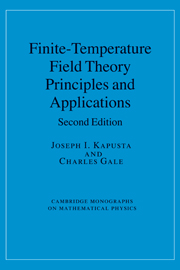Book contents
- Frontmatter
- Contents
- Preface
- 1 Review of quantum statistical mechanics
- 2 Functional integral representation of the partition function
- 3 Interactions and diagrammatic techniques
- 4 Renormalization
- 5 Quantum electrodynamics
- 6 Linear response theory
- 7 Spontaneous symmetry breaking and restoration
- 8 Quantum chromodynamics
- 9 Resummation and hard thermal loops
- 10 Lattice gauge theory
- 11 Dense nuclear matter
- 12 Hot hadronic matter
- 13 Nucleation theory
- 14 Heavy ion collisions
- 15 Weak interactions
- 16 Astrophysics and cosmology
- Conclusion
- Appendix
- Index
13 - Nucleation theory
Published online by Cambridge University Press: 04 November 2009
- Frontmatter
- Contents
- Preface
- 1 Review of quantum statistical mechanics
- 2 Functional integral representation of the partition function
- 3 Interactions and diagrammatic techniques
- 4 Renormalization
- 5 Quantum electrodynamics
- 6 Linear response theory
- 7 Spontaneous symmetry breaking and restoration
- 8 Quantum chromodynamics
- 9 Resummation and hard thermal loops
- 10 Lattice gauge theory
- 11 Dense nuclear matter
- 12 Hot hadronic matter
- 13 Nucleation theory
- 14 Heavy ion collisions
- 15 Weak interactions
- 16 Astrophysics and cosmology
- Conclusion
- Appendix
- Index
Summary
The dynamics of first-order phase transitions has fascinated scientists at least since the time of Maxwell and Van der Waals. Much work on the classical theory of the nucleation of gases and liquids was carried out in the early part of the 1900s, culminating in the theory of Becker and Döring. There were and still are many important applications, such as cloud and bubble chambers, the freezing of liquids, and precipitation in the atmosphere. The modern theory of nucleation was pioneered by Langer. Langer's theory is based in a more fundamental way on the microscopic interactions of atoms and molecules. It can also be applied close to a critical point. Nucleation theory has been extended to relativistic quantum field theory by Coleman and Callan for zero temperature and by Affleck and Linde for finite temperature. A coarse-grained relativistic field theory description was developed by Csernai and Kapusta for finite temperature and extended to finite density by Venugopalan and Vischer. Langer's results are recovered in the nonrelativistic limit. Applications here are to elementary particle phase transitions in the early universe, heavy ion collisions, and even the nucleation of black holes.
The goal of nucleation theory is to compute the probability that a bubble or droplet of the A-phase appears in a system initially in the B-phase near the critical temperature. Homogeneous nucleation theory applies when the system is pure; inhomogeneous nucleation theory applies when impurities cause the formation of bubbles or droplets. For the applications we have in mind, namely the early universe and very-high-energy nuclear collisions, it seems that homogeneous nucleation theory is appropriate.
- Type
- Chapter
- Information
- Finite-Temperature Field TheoryPrinciples and Applications, pp. 289 - 316Publisher: Cambridge University PressPrint publication year: 2006



